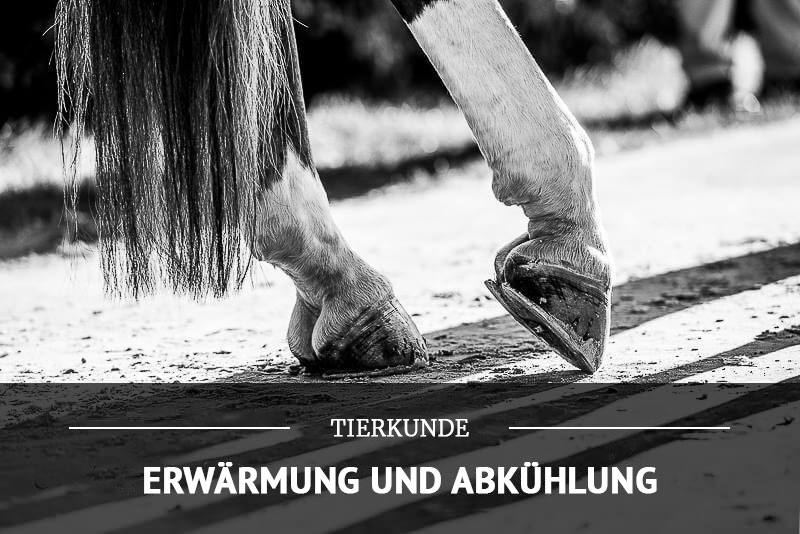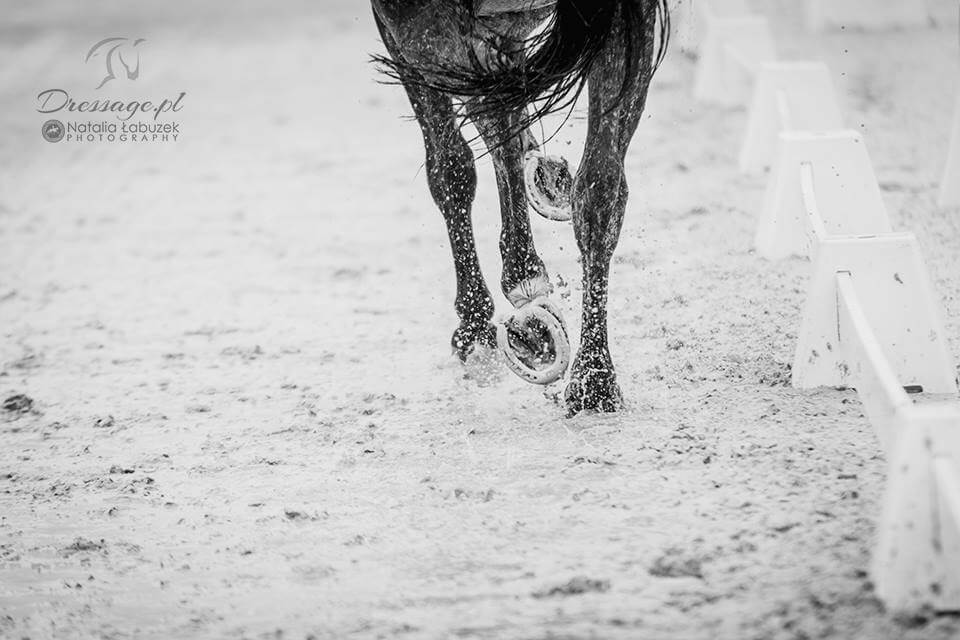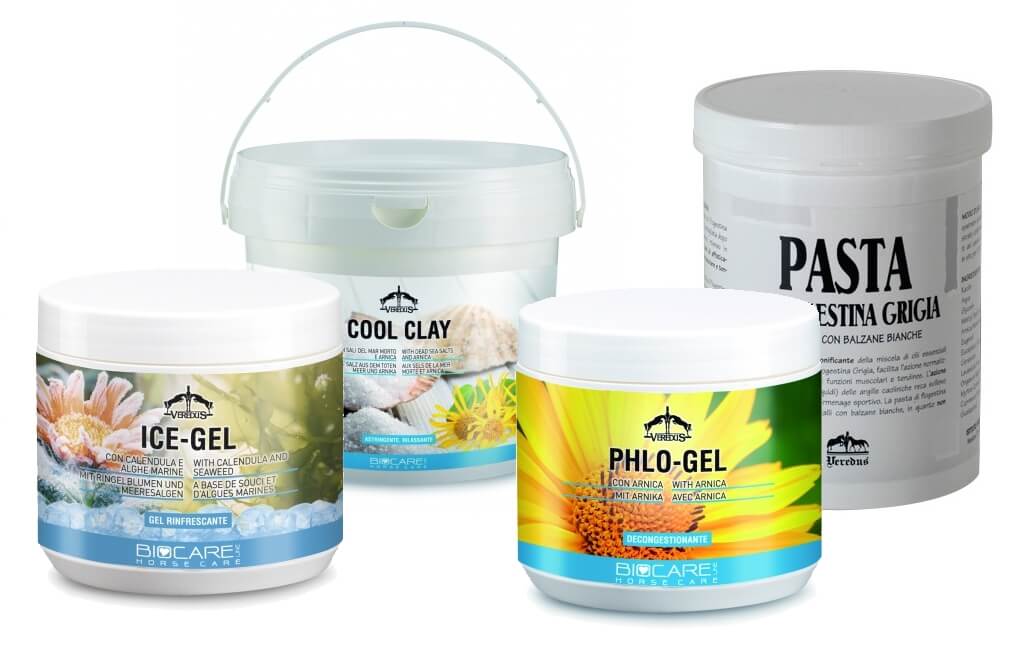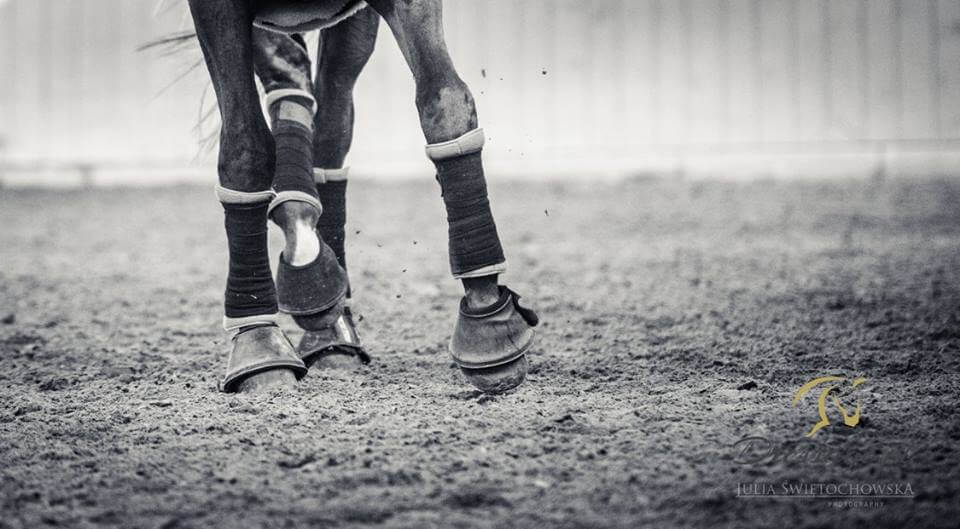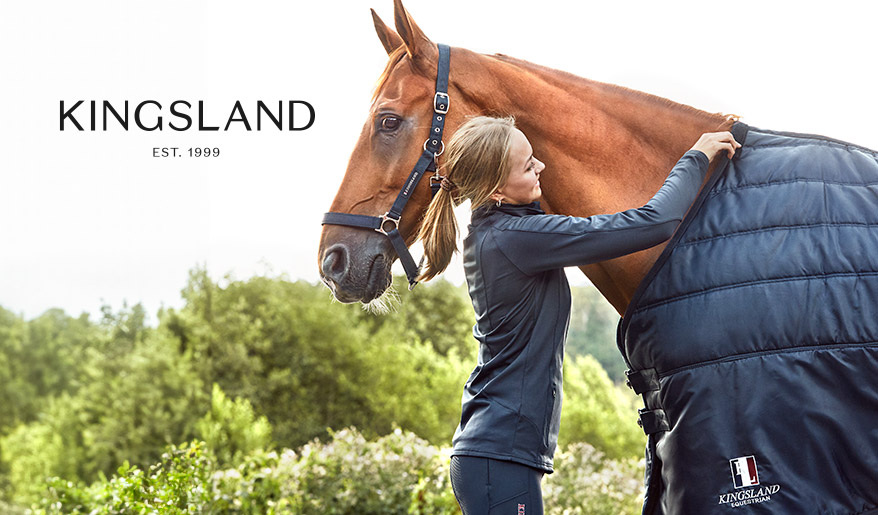Hintergrundquelle:
dressage.pl, Foto: Łukasz Kowalski
Der Winter ist eine Zeit, in der man sich leicht verletzen kann. Minusaußentemperatur, unzureichend aufgewärmtes Pferd = Verletzungen von Muskeln, Sehnen oder Bändern. Oft entsteht Eis, auf dem beschlagene Pferde leicht rutschen, was auch ihr myofasziales System belasten kann.
Wir gehen nach dem Training zurück in den Stall oder kommen für einen weiteren Ausritt und sehen, dass unser Pferd ein geschwollenes Glied hat. Viele von uns wissen nicht, was zu tun ist. Draußen ist es kalt und im Stall warm. Dieses Bein kühlen oder aufwärmen? Wir hoffen, Ihre Zweifel zu zerstreuen ;)
Wann Aufwärmen und wann Abkühlen
Grundlagen
Die Einwirkung von Wärme und Kälte ist eine der effektivsten Methoden, um die Heilung zu beschleunigen und die Dauer einer Verletzung zu verkürzen. Natürlich funktioniert diese Methode nur, wenn sie im richtigen Moment eingesetzt wird. Wir können auf diese Weise Weichteile, Muskeln, Sehnen und Bänder des Pferdes heilen.
Denken Sie jedoch daran, dass die Einwirkung von Hitze und Kälte auf Risse und ernsthafte Schäden an den oben genannten Geweben nicht wirkt und nicht ohne Rücksprache mit einem Tierarzt behandelt werden sollte.
Die Heiß-Kalt-Methode wirkt nur bei Prellungen, Zerrungen und Dehnungen, sowie als vorbeugende Maßnahme vor und nach dem Training, es fördert die Regeneration der Gliedmaßen.
Interessanterweise können wir dies auch zu Hause verwenden, zum Beispiel bei Prellungen, Zerrungen und Dehnungen.
Achtung!
Bei Verletzungen, die nicht länger als 36 Stunden andauern, kommt es bei Pferden immer zu Schwellungen und beim Menschen auch zu blauen Flecken und Prellungen.
Quelle: dressage.pl, Foto Natalia Łabuzek
Phase I - Abkühlung
Dies ist die Phase, in dem Schwellungen, Ödeme und Schmerzen auftreten. Sie dauert bis zu 36 Stunden nach der Verletzung des Pferdes. Nachfolgend finden Sie einige Beispielsituationen.
1. Wir kommen vom Training zurück und sehen, dass das Bein unseres Pferdes gefährlich zu wachsen beginnt. Das Pferd "tretet mit der Hufe am Boden" oder hinkt.
2. Wir nehmen das Pferd von der Weide und sehen, dass sein Hals eine Spur von einem saftigen Tritt hat. Die Stelle ist schmerzhaft und geschwollen.
3. Wir kommen in den Stall, um das Pferd zum Training zu bringen. Beim Putzen fällt auf, dass sein Hinterbein doppelt so groß ist wie die anderen.
Bevor wir etwas unternehmen, sollte man nach den Ursachen der Verletzung suchen. Wenn unser beschlagenes Pferd auf einer Weide mit Eis war, ist es vielleicht ausgerutscht und gegen etwas gestoßen, oder es ist gestürzt, hat einen Muskel oder ein Band gezerrt und sich so davor bewahrt hat, das Gleichgewicht zu verlieren. Möglicherweise geriet es in einen Kampf mit einem anderen Pferd.
Wenn die Verletzung nach dem Reiten oder der Rückkehr von der Weide aufgetreten ist, sollte man überlegen, was passieren könnte. Lahmheit allein bedeutet noch keine Gewebeschädigung. Das kann viele Gründe haben, daher ist es nicht ratsam, gleich „im Voraus“ zu handeln, sondern das erkrankte Glied genau zu untersuchen, auch den Huf des Pferdes, abzutasten. Jeder Temperaturunterschied sollte von uns festgestellt werden, weil das belastete Glied bzw. die belastete Stelle immer deutlich wärmer ist als die anderen. Zum Beispiel fühlt sich ein schmerzendes Bein im Vergleich zu den restlichen Gliedmaßen des Pferdes heiß an.
Wenn wir sicher sind, dass eine Verletzung vorliegt - eine Dehnung oder Zerrung eines Muskels, Bänder, Sehnen oder Weichteilschäden - sollte eine frische Schwellung/Ödeme (bis zu 36 Stunden nach Beginn der Verletzung) gekühlt werden.
Die grundlegende Kühlmethode besteht darin, lange Zeit Wasser über die Stelle zu gießen, zunächst mit lauwarmem Wasser und allmählich mit kälterem. Im Sommer ist das kein Problem, aber im Winter hat nicht jeder einen beheizten Stall und eine Waschstelle drinnen. Dann sollte man Salben und kühlende Tonerde wählen, die man auch nach der Wasserkühlung verwenden kann. Sie eignen sich nicht nur perfekt zur Behandlung von Verletzungen, sondern auch nach dem Training zur Entspannung und Regeneration der Gliedmaßen.
Eine Kältetherapie (Kryotherapie) hilft, Entzündungen vorzubeugen, die unbehandelt zu schwerwiegenderen Schäden führen könnten. Die Kälteeinwirkung verengt die Blutgefäße, was die Bildung von Blutergüssen und blauen Flecken bei Pferden verhindert, die unter dem Fell unsichtbar sind. Eine frühzeitige Kühlung der Verletzungsstelle kann die Behandlungszeit erheblich verkürzen und Gewebeschäden minimieren.
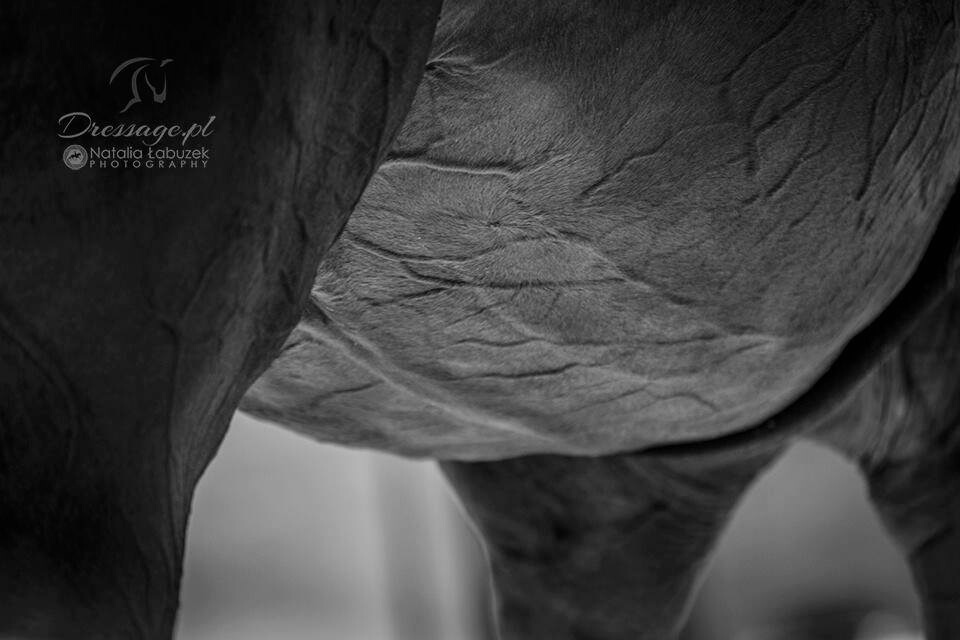
Phase II - abwechselndes Erwärmen und Kühlen
36 Stunden nach Beginn der Verletzung hört die Schwellung auf zu wachsen und es ist deutlich sichtbar, welchen Bereich sie betrifft. Auch die Gewebeschädigungsstelle wird härter.
Dies ist die Phase der alternierenden Warm-Kalt-Therapie, in der wir eine wärmende Salbe oder Tonerde auftragen sollten, um die Durchblutung zu verbessern, wodurch das Tempo der Gewebeheilung erhöht wird und geeignete biochemische Prozesse aktiviert werden, um sie zu regenerieren und wieder aufzubauen. Nach ca. 3-4 Stunden können Sie erneut kühlende Salben oder Tonerde auftragen, die der Neubildung von Schwellungen vorbeugen.
Je nach Ausmaß des Schadens kann diese Phase länger oder kürzer dauern, von mehreren Stunden bis hin zu einem Tag. Wir sollten jedoch eine deutliche Verbesserung sehen.
Achtung!
Indem wir eine stark wärmende Salbe verwenden, ohne darauf zu achten, dass es überhaupt zu einer Verletzung gekommen ist, schädigen wir gesundes Gewebe. Verwenden wir es also mit Vorsicht.
Wenn keine Verletzung vorliegt und wir uns nur um die Geweberegeneration nach dem Training kümmern, sollte man ein Präparat wählen, das nicht so stark wirkt (Beispiele für Präparate finden Sie unten auf dem Foto).
Phase III - Erwärmen
Unser Pferd sollte sich viel besser fühlen und die Schwellung zurückgehen oder sogar ganz verschwinden. Die Verletzungsstelle kann immer noch hart und steif sein, was dem Pferd Unbehagen bereitet. Die Temperatur der beschädigten Stelle sollte sich wieder normalisieren.
In dieser Phase sollten wir noch handeln, indem wir eine wärmende Salbe oder Tonerde auftragen. Es hilft, indem es die Durchblutung erhöht, um beschädigtes Gewebe zu reparieren und Verschmutzungen aus dem erkrankten Bereich zu entfernen. Aufwärmen beschleunigt den Heilungsprozess. Es kann auch besonders nützlich sein, wenn alte Lahmheiten zurückkehren.
Quelle: dressage.pl, Foto: Julia Świętochowska
Fragen und Antworten
1. Was tun, wenn die Verletzungsstelle warm ist?
Es lohnt sich, alle genannten Phasen durchzulaufen. Vom Abkühlen, über abwechselndes Erwärmen und Abkühlen, bis hin zum abschließenden Aufwärmen.
2. Was tun, wenn die Verletzungsstelle kalt ist?
Wenn die Möglichkeit besteht, dass wir die Verletzung nicht rechtzeitig bemerkt haben (z. B. nach dem Training hat das Pferd den Stall nicht verlassen und wir waren einige Tage nicht dort, sodass niemand bemerkt hat, dass etwas nicht stimmt ), sollte man die erste Phase - Abkühlen - überspringen und direkt zur Phase II übergehen: Erwärmen/Abkühlen und dann zu Phase III - Aufwärmen.
Wenn es sich vermutlich um eine alte Verletzung handelt, wie z. B. wiederkehrende Lahmheiten, dann lohnt sich nur das Aufwärmen zu machen.
Was ist, wenn es sich nicht um eine rechtzeitig erkannte Verletzung oder wiederkehrende Lahmheit handelt? In diesem Fall sollte man einen Tierarzt fragen, weil es sich um etwas Ernsteres handeln kann und unsere Behandlungen keine positive Wirkung haben werden.
3. Sollte man an der Verletzungsstelle Bandagen oder Gamaschen verwenden, die mit kühlender/wärmender Salbe bestrichen worden sind?
Die Antwort ist: definitiv nicht. Wenn wir die Gliedmaßen des Pferdes abkühlen, wärmt dies logischerweise die Verletzungsstelle. Also verneinen wir die Idee des Abkühlens.
Wenn wir Bandagen oder irgendwelche Gamaschen, sogar Transportgamaschen mit wärmender Salbe auf die Stelle legen, kann dies zu Verbrennungen führen. Wenn wir das Glied für längere Zeit wärmen möchten, ist es besser, sich für eine wärmende Tonerde zu entscheiden.
4. Wie sollte man die Gliedmaßen vor und nach dem Training pflegen?
Im Sommer lohnt es sich nach dem Training, die Gliedmaßen mit Wasser zu kühlen und so Gewebeschäden vorzubeugen. Das Gießen von Wasser aus einem Schlauch (Gartenschlauch) lockert müde Muskeln und entspannt sie nach dem Training. Wichtig ist jedoch, das Pferd „von unten“ zu kühlen, d.h. von der Hufe ausgehend, langsam in Richtung der Sprunggelenke und weiter. Denken Sie daran, Ihr Pferd auch im Sommer nicht mit eiskaltem Wasser zu übergießen. Die beste Lösung ist lauwarmes Wasser.
Es gibt auch viele Salben auf dem Markt, die darauf abzielen, die Gliedmaßen des Pferdes zu entspannen, zu erholen und zu regenerieren, sowohl nach als auch vor dem Training. Es gibt auch solche, die durch Massieren und Reiben der Pferdebeine vor dem Training oder Wettkampf die Durchblutung verbessern und den Körper des Pferdes besser aufwärmen, was besonders im Winter nützlich ist
5. Wann verwendet man Salben und wann Tonerde?
Man verwendet die Salbe gut in kurzen Abständen. Es lohnt sich, die Tonerde nachts aufzutragen, wenn das Pferd länger damit bleiben kann, ohne sie schnell abwaschen zu müssen.
6. Wie lange soll jeder Schritt dauern: I - Abkühlen, II - Erwärmen/Abkühlen und III - Erwärmen?
Es hängt alles davon ab, wie schwer der Schaden ist. Das Wichtigste ist, die Temperatur der Verletzungsstelle zu beobachten und zu überprüfen. Die ersten 36 Stunden können wir das warme Bein kühlen, wobei alles davon abhängt, wie viel Zeit zwischen der Verletzung und dem Zeitpunkt vergeht, an dem wir sie bemerken. Bei späterer Feststellung darf die Abkühlzeit kürzer sein. Die Salbe kann alle 3-4 Stunden (max. 4 mal täglich) aufgetragen werden, um das Bein anfangs recht intensiv zu kühlen, und nachts tragen Sie kühlende Tonerde auf.
Die Erwärm-/Abkühlphase – sie soll die Schwellung zurückführen und die Verletzungsstelle wird nicht mehr viel heißer als der Rest der Gliedmaßen. Je nachdem, wie umfangreich die Verletzung ist, kann diese Phase zwischen 24 und 48 Stunden dauern. Der Zeitabstand zwischen dem Auftragen der einen oder anderen Salbe beträgt mindestens 4-5 Stunden (max. 3-4 Mal/Tag: erstes Mal - Erwärmen, zweites - Abkühlen, drittes Erwärmen ... usw.). Zusätzlich können Sie nachts wärmende Tonerde auftragen, aber morgens sollten Sie das Bein wieder mit Salbe kühlen.
Die letzte Phase – das Erwärmen – sollte stattfinden, wenn die Verletzungsstelle normale Temperatur hat. Es lohnt sich, nach Abklingen der Schwellung und nach Rückkehr zur Normaltemperatur diese Stelle noch einige Tage zu erwärmen, bis die Gliederschmerzen und eventuelle Lahmheiten nachlassen. Die wärmende Salbe darf max. 2-3 Mal/Tag im Abstand von mindestens 4-5 Stunden verwendet werden.
7. Wie viel Salbe sollte man auf einmal auftragen?
Denken Sie daran, dass man dabei nicht übertreiben darf. Es lohnt sich, die Salbe in die Verletzungsstelle einzureiben, damit die Menge des aufgetragenen Präparats die Gliedmaßen des Pferdes befeuchtet und nach einiger Zeit einzieht. Es ist unakzeptabel, eine dicke Schicht aufzutragen, die am Bein des Pferdes herunterläuft. Anders verhält es sich mit Tonerde, die viel aufgetragen werden sollte, damit sie nach dem Trocknen ein bisschen wie ein dünnes Pflaster auf einem Pferdebein aussieht.
Denken Sie daran, alle Salben und Tonerden in Gummihandschuhen aufzutragen! Wenden wir sie ungeschützt an, nimmt unsere Haut die Wirkstoffe auf und spürt ihre Wirkung.
Wie vermeide ich Schwellungen und Zerrungen?
Zerrungen oder Belastungen von Muskeln, Bändern und Sehnen betreffen am häufigsten die Gliedmaßen des Pferdes. Sie sind auch am anfälligsten für mechanische Verletzungen. Bei Springen, Longieren und Ausritten sollte man daher Pferdegamaschen anlegen, die in erster Linie die Sehnen schützen. In der Dressurarbeit sind jedoch Bandagen oder Dressurgamaschen perfekt. Auf Reisen ist das Anlegen von Transportgamaschen erforderlich.
Quelle: dressage.pl, Foto: Julia Świętochowska
Denken Sie daran, dass es besser ist zu schützen und vorzubeugen als zu heilen ;)



